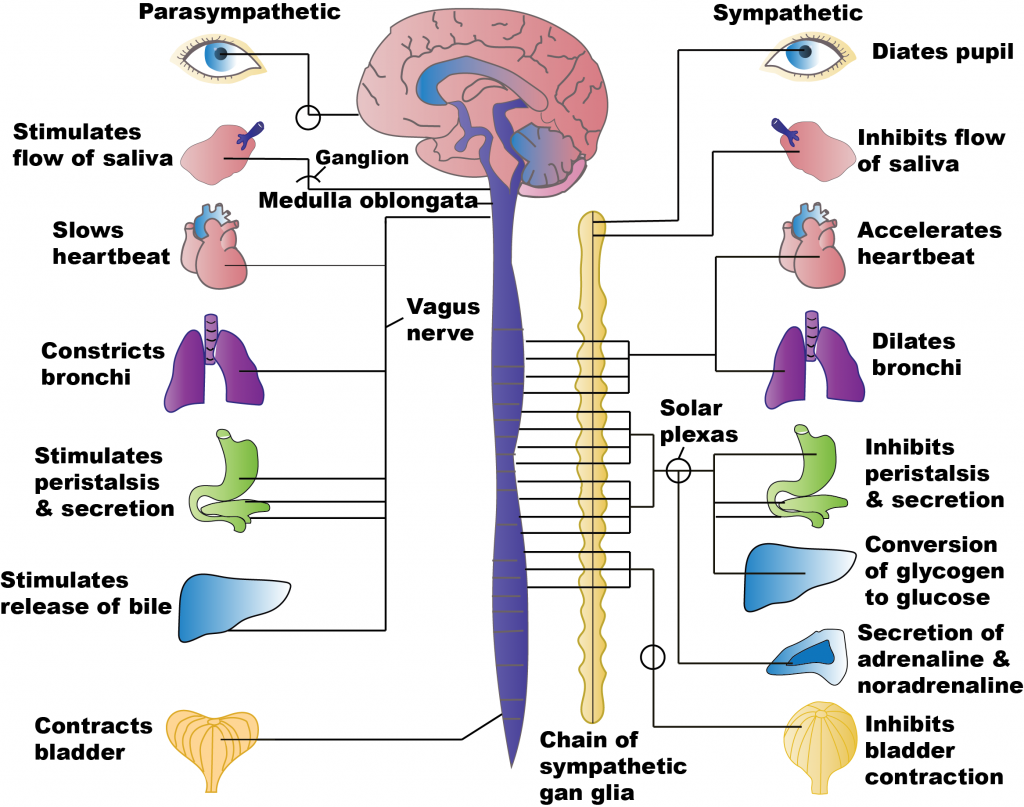Sympathetic nervous system (SNS) activation can change these body functions except:
Increase heart rate
Increase blood glucose
Increase GI motility and movement
Increase blood pressure
The Correct Answer is C
Choice A Reason:
The sympathetic nervous system (SNS) is responsible for the “fight or flight” response, which prepares the body to respond to perceived threats. One of the primary effects of SNS activation is an increase in heart rate. This is achieved through the release of catecholamines like adrenaline, which stimulate the heart to pump more blood to vital organs and muscles.
Choice B Reason:
Another effect of SNS activation is an increase in blood glucose levels. This occurs because the body needs more energy to respond to stress. The SNS stimulates the liver to release glucose into the bloodstream, ensuring that muscles and other tissues have enough energy to function effectively during a stressful situation.
Choice C Reason:
The correct answer is that SNS activation does not increase GI motility and movement. In fact, it has the opposite effect. During a “fight or flight” response, the body prioritizes functions that are critical for immediate survival, such as increased heart rate and blood flow to muscles. As a result, non-essential functions like digestion are slowed down. The SNS decreases GI motility and movement to divert energy and blood flow to more critical areas.
Choice D Reason:
SNS activation also leads to an increase in blood pressure. This is achieved by constricting blood vessels and increasing the force of heart contractions. The purpose of this response is to ensure that enough blood and oxygen are delivered to essential organs and muscles during a stressful situation.

Nursing Test Bank
Naxlex Comprehensive Predictor Exams
Related Questions
Correct Answer is B
Explanation
Choice A Reason:
Atrophy refers to the reduction in size or wasting away of an organ or tissue due to a decrease in cell size or number. It is not a type of cell death but rather a process of cell shrinkage and loss of function. Therefore, it does not directly relate to the damage caused to nearby cells.
Choice B Reason:
This is the correct answer. Apoptosis is a form of programmed cell death that occurs in a controlled and regulated manner. It allows for the removal of damaged or unnecessary cells without causing an inflammatory response or damage to surrounding tissues. During apoptosis, cellular components are neatly packaged into vesicles called apoptotic bodies, which are then phagocytosed by neighboring cells or immune cells, preventing the release of harmful substances.
Choice C Reason:
Necrosis is a form of traumatic cell death that results from acute cellular injury. It often leads to the uncontrolled release of cellular contents, causing inflammation and damage to surrounding tissues. This process can be detrimental to nearby cells and is generally considered more harmful than apoptosis.
Choice D Reason:
Lysis refers to the breaking down or destruction of cells, often due to external factors such as toxins, infections, or immune responses. Like necrosis, lysis can result in the release of cellular contents into the surrounding environment, leading to inflammation and damage to nearby cells.
Correct Answer is C
Explanation
Choice A Reason:
The sympathetic nervous system (SNS) is responsible for the “fight or flight” response, which prepares the body to respond to perceived threats. One of the primary effects of SNS activation is an increase in heart rate. This is achieved through the release of catecholamines like adrenaline, which stimulate the heart to pump more blood to vital organs and muscles.
Choice B Reason:
Another effect of SNS activation is an increase in blood glucose levels. This occurs because the body needs more energy to respond to stress. The SNS stimulates the liver to release glucose into the bloodstream, ensuring that muscles and other tissues have enough energy to function effectively during a stressful situation.
Choice C Reason:
The correct answer is that SNS activation does not increase GI motility and movement. In fact, it has the opposite effect. During a “fight or flight” response, the body prioritizes functions that are critical for immediate survival, such as increased heart rate and blood flow to muscles. As a result, non-essential functions like digestion are slowed down. The SNS decreases GI motility and movement to divert energy and blood flow to more critical areas.
Choice D Reason:
SNS activation also leads to an increase in blood pressure. This is achieved by constricting blood vessels and increasing the force of heart contractions. The purpose of this response is to ensure that enough blood and oxygen are delivered to essential organs and muscles during a stressful situation.

Whether you are a student looking to ace your exams or a practicing nurse seeking to enhance your expertise , our nursing education contents will empower you with the confidence and competence to make a difference in the lives of patients and become a respected leader in the healthcare field.
Visit Naxlex, invest in your future and unlock endless possibilities with our unparalleled nursing education contents today
Report Wrong Answer on the Current Question
Do you disagree with the answer? If yes, what is your expected answer? Explain.
Kindly be descriptive with the issue you are facing.
